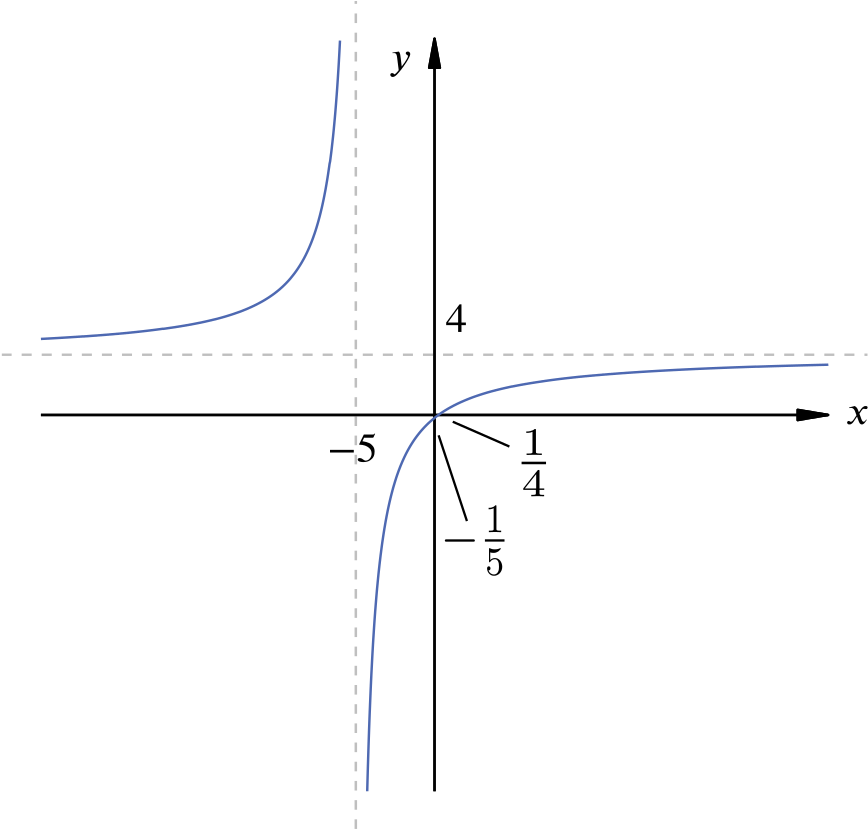- Sketch the graph of \[ y = \frac{4x-1}{x+5}. \]
In sketching the graph, we’ll look at four different features of the function:
- its intercepts with the axes;
- its asymptotic behaviour;
- its signs in various regions; and
- its turning points, if it has any.
Intercepts
The \(y\)-intercept is \[ y = y(0) = \frac{4 \times 0 - 1}{0+5} = -\frac{1}{5}. \]
The \(x\)-intercepts are the values of \(x\) such that \[ 0 = \frac{4x-1}{x+5}; \] there’s one such value, \(x = \dfrac{1}{4}\).
Asymptotic behaviour
There’s a single vertical asymptote when the denominator is zero, the line \(x = -5\).
If we rewrite the function as \[ \frac{4x-1}{x+5}=4-\frac{21}{x+5} \] it is easier to see that as \(x \to \infty\), \(y \to 4\) and that as \(x \to -\infty\), \(y \to 4\) so there’s a single horizontal asymptote, \(y = 4\).
Signs
The sign of \(y\) can only change when \(x\) moves across a vertical asymptote or an \(x\)-intercept.
The \(x\)-axis falls into three regions, \(x < -5\), \(-5 < x < \dfrac{1}{4}\), and \(x > \dfrac{1}{4}\), and in each of these regions \(y\) has a constant sign.
We can determine the sign of \(y\) in each of these regions by looking at the signs of the numerator and denominator separately.
- In the first region, \(4x - 1 < 0\) and \(x + 5 < 0\), so \(y\) is the quotient of two negative expressions, and is therefore positive.
- In the second region, \(4x - 1 < 0\) and \(x + 5 > 0\), and so \(y < 0\).
- In the third region, \(4x - 1 > 0\) and \(x + 5 > 0\), and so \(y > 0\).
Turning points
By considering the function in the form \[ \frac{4x-1}{x+5}=4-\frac{21}{x+5} \] we see that it is a transformation of \(y = \dfrac{1}{x}\). Therefore there are no turning points.

Hence, or otherwise, find the set of values of \(x\) for which \[ -1 < \frac{4x-1}{x+5} < 1. \]
The sketch shows that we need the set of \(x\)-values from \(a\) to \(b\), where \(a\) is the solution of \(-1=\dfrac{4x-1}{x+5}\), and \(b\) is the solution to \(\dfrac{4x-1}{x+5}=1\).
We have \[\begin{align*} -1&=\dfrac{4x-1}{x+5}\\ &\implies -x-5=4x-1 \\ &\implies x = -\dfrac{4}{5}. \end{align*}\] and also \[\begin{align*} \dfrac{4x-1}{x+5}&=1 \\ &\implies 4x-1=x+5 \\ &\implies x = 2. \end{align*}\]Thus \(a = -\dfrac{4}{5}\), and \(b = 2\), and the set of values for \(x\) that we need is \(\left\{ x \in \mathbb{R} : -\dfrac{4}{5}< x < 2 \right\}\).
- Find the set of values of \(x\) for which \[ 3x^3 + 2x^2 + 6 \ge 19x. \]
Now \[ 3x^3 + 2x^2 + 6 \ge 19x \iff 3x^3 + 2x^2 - 19x + 6 \ge 0, \] so if we let \(p(x) = 3x^3 + 2x^2 - 19x + 6\), then we have to find the set of values of \(x\) for which \(p(x) \ge 0\).
Can we factor the polynomial \(p(x)\)?
By the factor theorem, \((x-a)\) is a factor of \(p(x)\) if and only if \(p(a) = 0\).
Let’s try a few different values for \(x\): every cubic equation has at least one real root, and if this is an integer, we have a chance of finding it here.
- \(p(0) = 6\);
- \(p(1) = 3 + 2 - 19 + 6 = -8\);
- \(p(2) = 3 \times 8 + 2 \times 4 - 19 \times 2 + 6 = 24 + 8 - 38 + 6 = 0\).
By equating coefficients, we have that \(\alpha = 3\), \(\gamma = -3\), and \(\beta - 2\alpha = 2\), i.e. \(\beta = 8\). Thus, \[ p(x) = (x-2)(3x^2 + 8x - 3). \] Factorising, we have \[ 3x^2 + 8x - 3 = (3x-1)(x+3). \] Therefore \[ p(x) = (x-2)(3x-1)(x+3). \]
The sign of \(p(x)\) can only change as \(x\) passes over a root of \(p(x)\); these roots are \(x = -3\), \(x = \dfrac{1}{3}\), and \(x = 2\).
This divides the \(x\)-axis into four regions.
- In the first region, with \(x < -3\), all three factors are negative, so \(p(x) < 0\).
- In the second region, with \(-3 < x < \dfrac{1}{3}\), two factors are negative and one is positive, so \(p(x) > 0\).
- In the third, with \(\dfrac{1}{3} < x < 2\), one factor is negative and two are positive, and so \(p(x) < 0\).
- Finally, with the fourth, with \(x > 2\), all three factors are positive and therefore \(p(x) > 0\).
We therefore have that \[ \{ x \in \mathbb{R} : p(x) \ge 0 \} = \{ x \in \mathbb{R} : x \ge 2 \} \cup \left\{ x \in \mathbb{R} : -3 \le x \le \frac{1}{3} \right\}. \]

